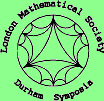 |
|
| Home | |
| Programme | |
| Short Courses | |
| Talks | |
| Posters | |
| For Presenters | |
| Participants | |
| Travel | |
| Recreation |
LMS Durham Symposium
Computational methods for wave propagation in direct scattering
Ivan Graham (Bath. UK)
Numerical aspects of (conical) diffraction coefficient computations
Abstract
The computation of diffraction coefficients for the scattering of high-frequency acoustic waves by conical scatterers can be reduced to the solution of a family of homogeneous boundary value problems for the Laplace-Beltrami-Helmholtz equation on a portion of the unit sphere bounded by a simple closed contour (in fact the intersection of the sphere with the conical scatterer). Distance on the contour is geodesic distance on the sphere. The diffraction coefficient may be determined by then integrating the resulting solutions with respect to the wave number ([1]).
In this talk we discuss the numerical computation of the diffraction coefficients using the boundary integral method, with the classical double layer potential approach. The kernels of the spherical integral operators which arise from this application have a diagonal singularity of the same type as the corresponding operators for the planar Helmholtz equation. This allows us to prove stability and convergence for appropriate discrete collocation methods in the case of smooth cones. Moreover a more refined analysis (adapting the analysis of boundary integral equations on planar corner domains ([2]) to the current problem) allows us to extend the convergence theory to the important practical case of conical scatterers with lateral edges. Suitable mesh grading near the corners is needed to ensure optimal convergence rates.
Diffraction coefficients for electromagnetic wave scattering can also be computed by a generalisation of this technique, leading to a system of boundary integral equations of the type discussed above.
The evaluation of the kernel of the integral equation involves computing the (derivative of the) Legendre function with complex index and for this we employ a method which combines solving Legendre's differential equation (when this equation is not singular), together with suitable asymptotic expansions near singular points.
The computations and much of the detailed analysis will be part of the forthcoming PhD thesis of BD Bonner.
[1] V.M.Babich, V.P.Smyshlyaev, D.Dement'ev and B.A.Samokish, SIAM J Appl Math 60(2000), 536-573.
[2]J.Elschner and I.G. Graham, Numerical methods for integral equations of Mellin type, in Numerical Analysis 2000, Volume 6: Ordinary differential and Integral Equations, C.T.H. Baker, J.D. Pryce, G.Vanden Berghe and G.Monegato, eds. Elsevier, Amsterdam, 2001, also J. Comp. Appl. Math. 125 (2000), 423-437.